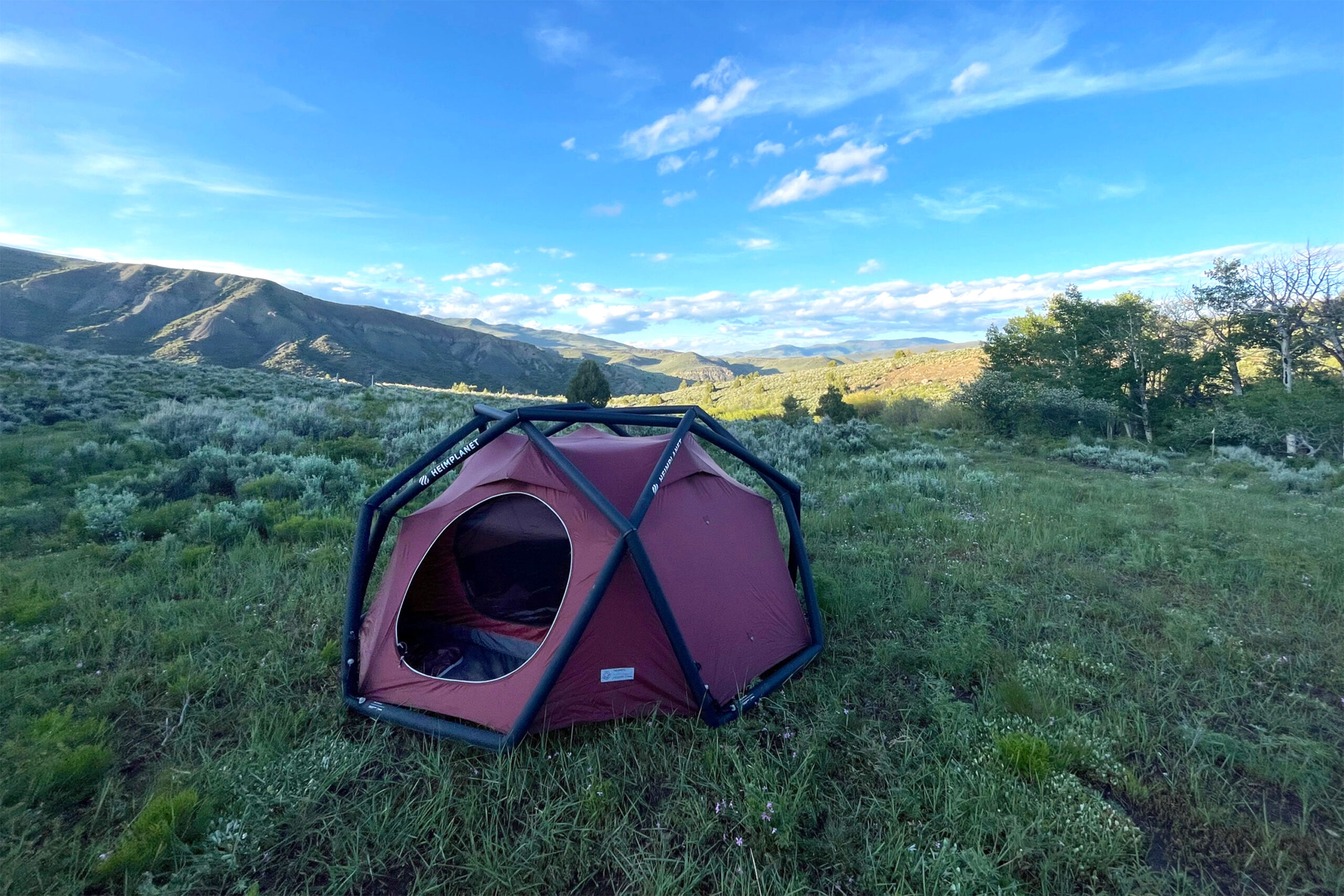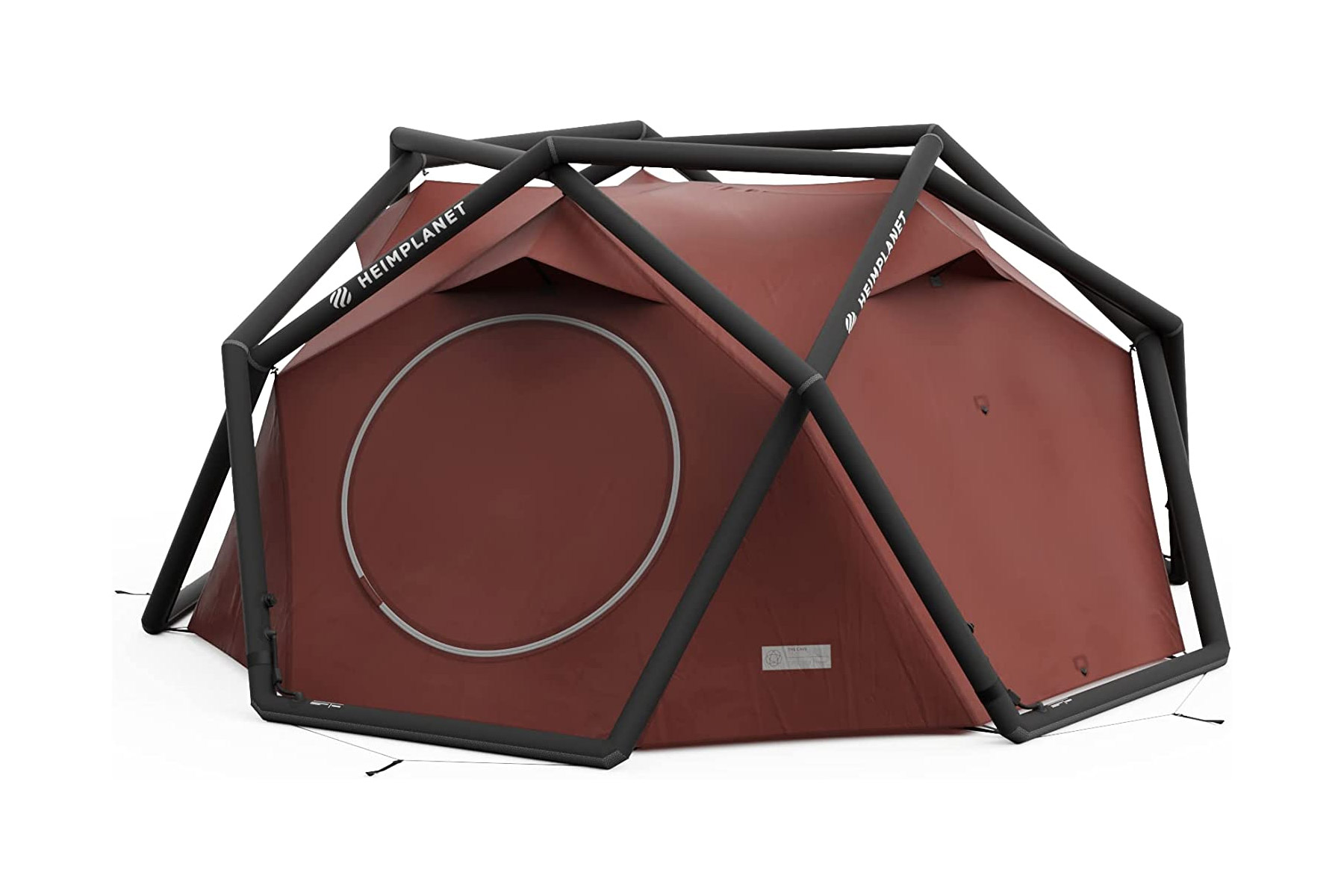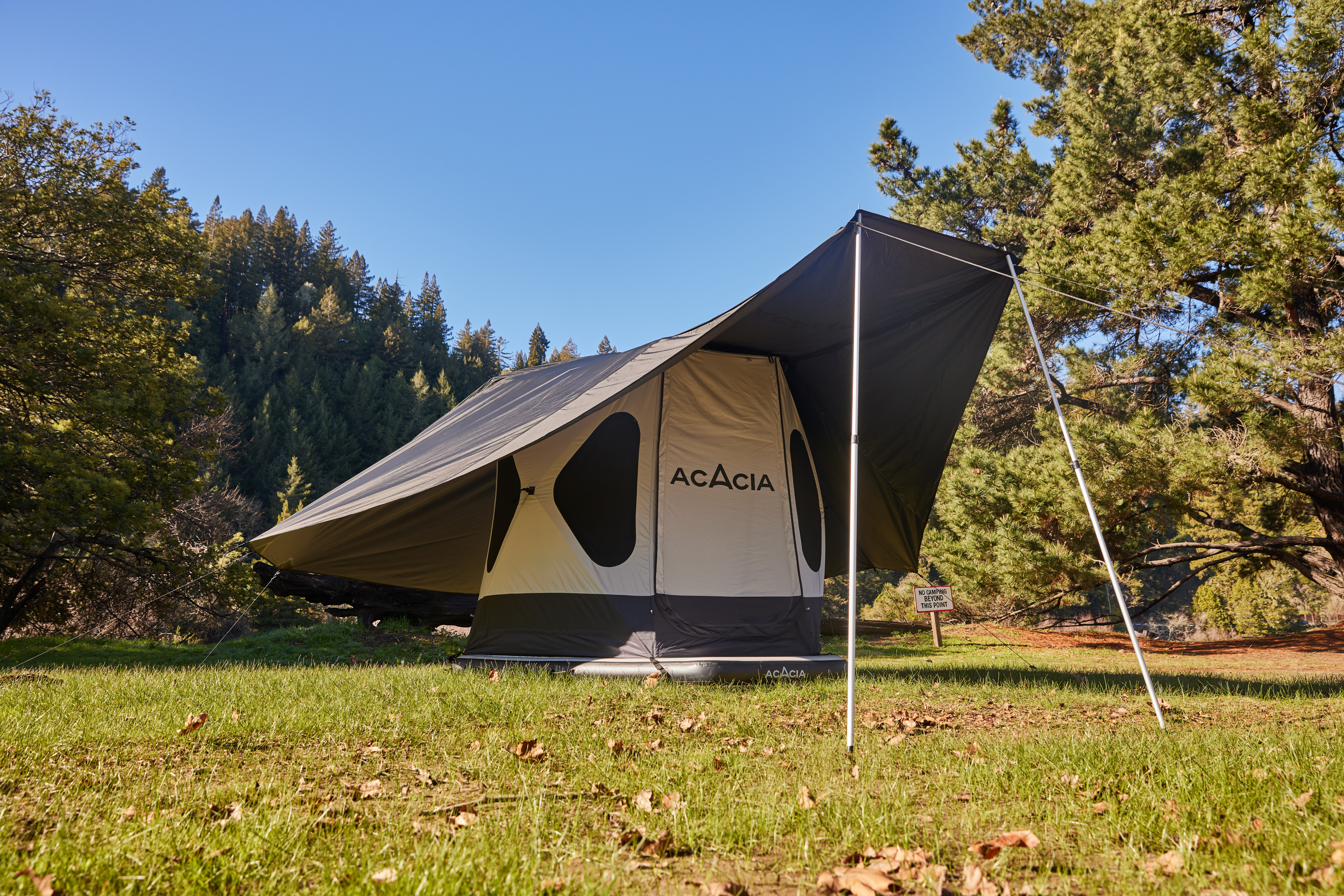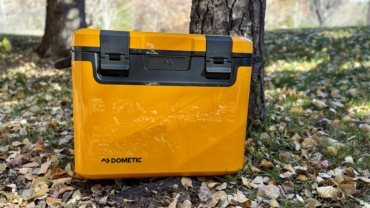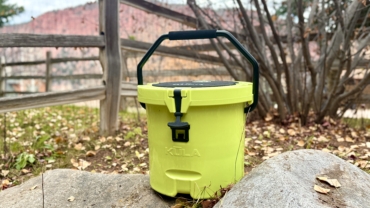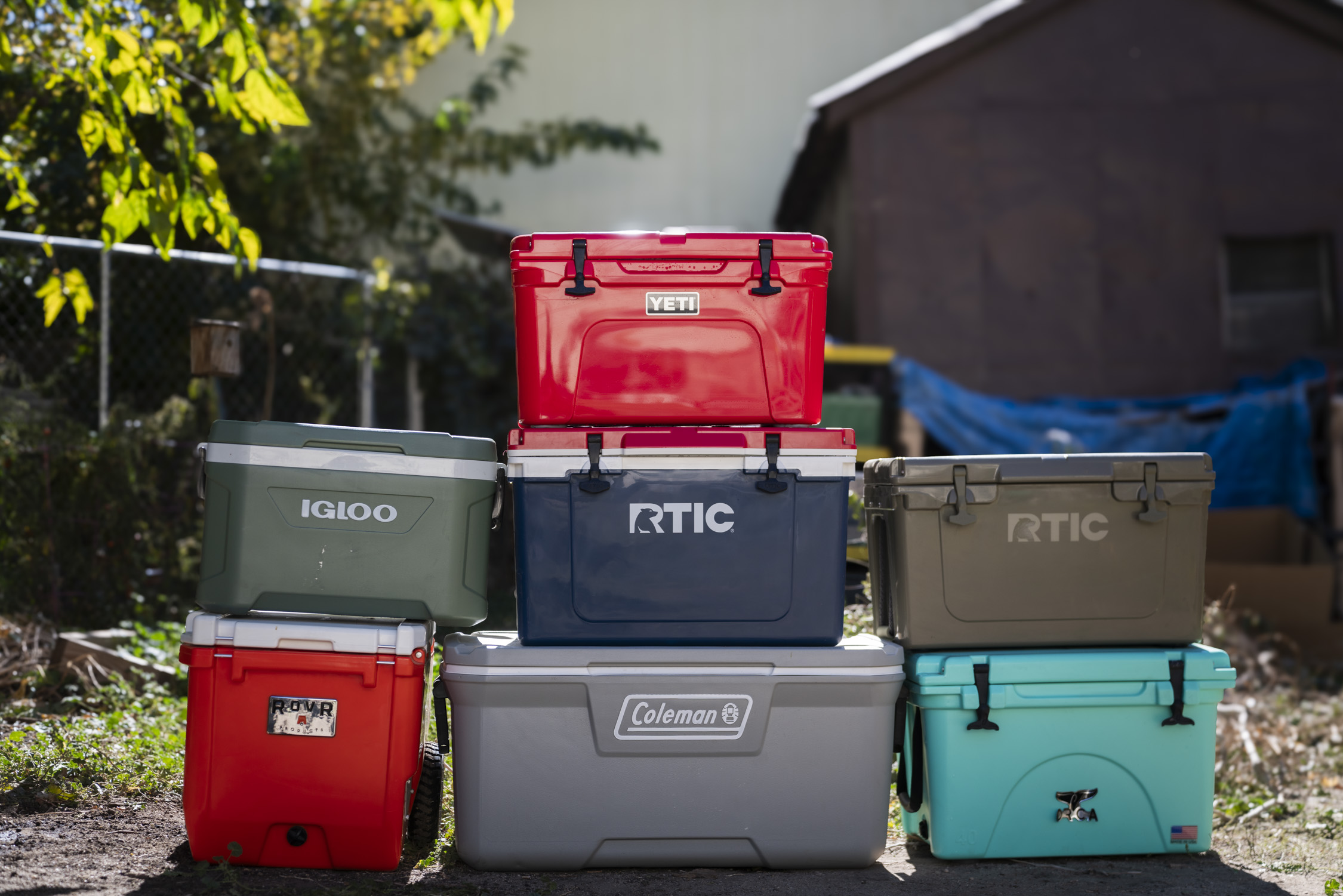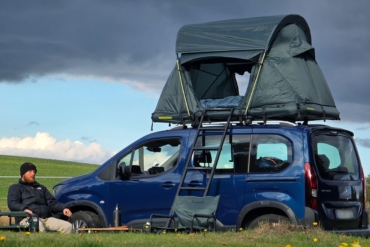The second time I set up the Heimplanet Cave XL, it was daytime and the weather was perfect. I pulled it out of the stuff sack, unrolled it, and started pumping. Like a bounce castle, the inflatable Cave turned into a tent. No poles, no clipping, nothing. I just threw five stakes into the ground to stop it from flying away and that was it. Compared to the first time I’d set it up, this was a much faster process.
Heimplanet claims that the Cave tent can be set up in less than a minute. But you’d have to be moving comically fast to hit that mark. After practicing, it still took me about 3 minutes to get it fully assembled — which is still faster than any other tent I’ve used.
Heimplanet just relaunched as a brand in North America this past January. It is working with several partners to sell its tents online and in brick-and-mortar stores. So if you haven’t heard of the brand yet, you might soon be seeing more of it.
It’s rare that a new tent design comes along that’s truly revolutionary. Or at least, one that’s completely different than what’s already out there. The Cave XL from Heimplanet is that. I put it to the test camping throughout a particularly rainy spring in central Colorado and Utah.
In short: Heimplanet just relaunched as a brand in North America this past January. And the brand’s Cave XL inflatable tent ($1,249) is nothing like the car camping tents you’re accustomed to. It relegates tent poles to the past in favor of an inflatable exoskeleton. Sound complicated? It is — for its first setup. After that, the Cave transforms from a stuff-sack to a fully pitched tent faster than any other tent I’m aware of. It’s sturdy, roomy, and fears no storm. It’s not without its tradeoffs, however, which will certainly turn some campers away.
- Pack size: 26.0 x 51.0 x 21.0 cm / 10.24" x 20.08" x 8.27"
- Weight: 5.4 kg / 11.99 lbs.
- Footprint: 5.4 m² / 0.5 sq. ft. (Inner tent: 4.1 m² / 0.5 sq. ft.)
- Inner tent height: 113.0 cm / 44.49"
- Total height: 131.0 cm / 51.57"
- Tent floor: 70D nylon taffeta DWR PU (water column: 5,000 mm)
- Inner tent: 40D nylon ripstop DWR (breathable)
- Flysheet: 40D double ripstop HT polyester PU (water column: 3,000 mm)
- Airframe: High-tenacity (HT) polyester, TPU
Pros
- Very fast and easy to set up (after the first time)
- Bombproof and sturdy
- Spacious, easily fits 3-4 people
Cons
- First setup is a little tricky
- Slightly vulnerable to punctures or tears
- Expensive car camping tent
Heimplanet Cave XL Tent: Review

Heimplanet Cave: Initial Setup
Let’s rewind, back to the first time I tried to set this thing up. Of course, I didn’t read the directions or watch Heimplanet’s handy setup guide. I was an overconfident, self-described “camping expert” — no tent could outsmart me, I figured.
My friend Jake and I showed up to our group’s agreed-upon Moab campsite in the dark, ready to just roll the thing out and pump it up. It was just starting to rain. But that was fine, because in seconds we’d have shelter. Right?

Wrong. Had I done any reading, I would have learned that the first setup is the most intricate. That’s when you have to attach all the pieces, clip the inner tent to the exoskeleton, and get the spacing all figured out.
It wasn’t quick — taking at least two beers each.
Could that initial setup have taken less than 10 minutes with appropriate preparation and an ounce of forethought? OK, yes; you’ve got me there.

The Tent Body
After that initial setup, though, the ease this tent offers is objectively incredible. It takes just 1 to 3 minutes if you know what you’re doing. It’ll be on the faster end of that spectrum if you’ve got a friend pumping while you plant stakes. My favorite heavy-duty tent, the Big Agnes Battle Mountain 3, takes at least 10 minutes to set up in good conditions. Smaller, simpler tents take less.
Nevertheless, 1 to 3 minutes is pretty dang quick — especially for a tent this big and this sturdy.
Takedown is equally as easy. Unscrew one of the valves near the ground and the whole thing deflates and collapses. Just roll it up to get the excess air out and stuff it into the generous waterproof stuff sack.
The Heimplanet Cave comes in several variations. I tested the XL (three to four people) four-season version. The Cave also comes in a standard three-season XL that employs more mesh for enhanced breathability and the “classic” Cave, suited for two to three people.
And, just this season, Heimplanet announced that it was collaborating with London-based streetwear label Maharishi to create a limited-edition “Golden Tigerstripe Camouflage” color version of the Cave.

Exterior
The exoskeleton of the Cave is made of high-tenacity polyester and TPU. There isn’t a pressure gauge. But when the airframe is filled, it’s formidable.
Because the tubes are lashed together with Velcro at the crossings, the whole frame is impressively strong. It’s also highly resilient. It will flex with a heavy gust of wind but then bounce right back to normal, ready for the next force.

It’s been a particularly rainy spring in Colorado. I sat through several squalls and even dumped our remaining 5-gallon water jug on the Cave XL for good measure to test its waterproofing.
As you’d expect from a $1,200 tent, no water gets in. Despite having a fairly flat top, water beads and evaporates but never soaks in, thanks to the 40D double ripstop high-tenacity polyester fly. That might start to change with wear and use over multiple seasons — but at least initially, the waterproofing seems reliable.

The five tent stakes are critical for pulling the footprint and frame to “full mast.” However, I didn’t feel the need to add the included guylines to pull out the walls of the tent further. The whole thing was taut without them, and there’s enough distance between the rainfly and the body of the inflatable tent that water didn’t soak through.

Interior
The Heimplanet Cave XL is designed for three to four people. I’d call it a car camping three to four — not a backpacking three to four. By that, I mean you can easily fit four in there, or three and a bunch of gear, or three and one big dog (like my chonky Berner, Tallie).
The only limitation is the single door. The edge sleepers will have to crawl over the two middle sleepers to get out in the middle of the night.
My friend Jake is vertically abundant — 6’6” end to end. He’s struggled with round tents in the past because he requires a full-diameter line (right in the middle) to get the most extension. The Cave XL was no different — he required the middle. But he had more than enough room at the foot and head to fully stretch out.

The domed structure makes the inside of the inflatable tent feel roomy and luxurious. Multiple campers can sit up straight and unencumbered without getting in each other’s way thanks to a 44.5-inch ceiling height. It’s a perfect place to hunker down and play cards during a storm.
There’s also a huge number of storage pockets along the walls and an included gear loft. So, each inhabitant can get their own storage to keep the place feeling organized.

Weight
There’s no getting around the fact that the Cave XL inflatable tent is a tank at 12 pounds. You won’t be carrying this thing on your back for very long, but that’s also not what it’s designed for. This tent lands firmly in the car camping, overlanding, rafting, or hunting realms where you’ve got some kind of assistance to get it to the campsite.
Twelve pounds isn’t out of this world for a tent, though. The renowned Mountain Hardwear Trango 4 has a packed weight of 12 pounds and hits the same price point. The popular The North Face Wawona 4 tent is even a pound heavier (yet a third of the price).
The difference between those tents and the Cave is that it isn’t practical to separate the Cave’s exoskeleton from the fly and tent body to share the weight between several backpackers.

The Cave XL also has a fairly large pack size, as you’d expect. But it’s manageable as part of a car camping kit. The kicker is the pump that you need to tote along to set it up. The floor pump (purchased separately) is big. It’s the same type of ultra-efficient pump you’d fill a packraft or paddleboard with.
It’s an awkward thing to pack if you’re not already hauling one around for watercraft. Heimplanet also sells a much more packable hand pump, which I didn’t test. That will most certainly erase the tent’s quick setup prowess in exchange for packability.

Durability
I didn’t encounter a single issue with the inflatable airframe. But I did almost set it up on a cactus the first time, which made me wonder — what would I do if it punctured?
Heimplanet thought of that. That’s why it includes a handy field repair kit with each tent. On top of that, the air chambers can be isolated using the pinch clips spaced out along the bottom sections of the exoskeleton. So, you can close off a punctured section and inflate the rest so the tent will still stand with plenty of structure.
Individividual exoskeleton struts are also replaceable in case one gets thrashed beyond repair. If that doesn’t work, Heimplanet also throws in a lifetime warranty promising repair or replacement in most cases.
At the end of their products’ lives, Heimplanet offers a unique “Restore” recycling program that puts up to 20% of the purchase price back in your wallet. That’s a significant chunk of change considering the price tag.
About That Price Tag
The Heimplanet Cave XL 4-Season inflatable tent retails for $1,250. That’s steep for a car camping tent. But it isn’t unheard of.
While the Heimplanet Cave is more than double — in some cases triple — the cost of some of our favorite car camping tents, it’s the same price as the REI Wonderland X. In fact, it’s less than the Space Acacia glamping tent ($1,736). So, it isn’t even the most expensive option on the market.
Still, there’s no ignoring that most four-person car camping tents are going to cost a fraction of the Heimplanet Cave XL 4-Season inflatable tent. That’s just a fact — and one that will turn a lot of people off.
Heimplanet Cave XL Tent: Conclusion

When I first saw the Heimplanet exoskeleton concept, I thought it was a neat, yet expensive solution looking for a problem. Traditional tent poles do a fine job, are plenty durable, and they’re cheap.
After spending time in the Cave XL inflatable tent, though, I’ve grown to dig it. There’s no other tent like this on the market. It’s strong, ultra-fast pitching, and weatherproof, and it comes with a great warranty. Whether it’s a step forward or laterally in tent design, however, I’m still not sure.
The Cave XL is a high-quality product that will more than meet the needs of the campers who use it. Especially for those that get to their campsite by car, boat, donkey, e-bike or e-moto, or any other assisted means.
There’s no getting around the fact that it comes with some distinct tradeoffs. It’s heavy. It requires lugging around a pump. And for the price, you could buy three tents from another brand.
Nevertheless, this equation will make sense for a lot of campers who want the fastest-pitching, most futuristic tent on the market.
